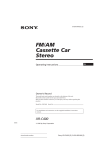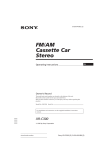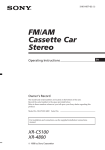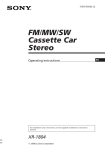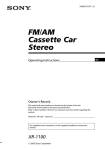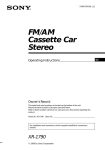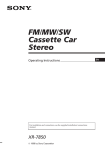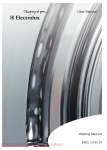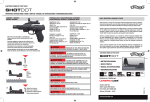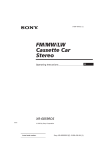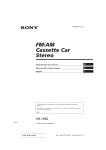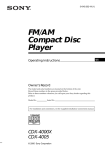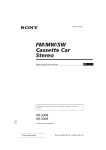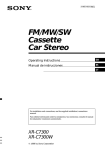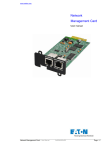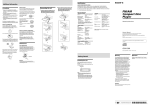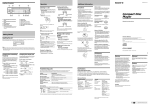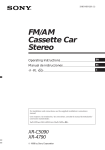Download WX-C55 Changer Control Audio Master
Transcript
Changer Control Audio Master Operating Instructions Owner’s Record The model and serial numbers are located on the bottom of the unit. Record the serial number in the space provided below. Refer to these numbers whenever you call upon your Sony dealer regarding this product. Model No. WX-C55 Serial No. For installation and connections, see the supplied installation/connections manual. WX-C55 1999 by Sony Corporation US Warning Welcome ! This equipment has been tested and found to comply with the limits for a Class B digital device, pursuant to Part 15 of the FCC Rules. These limits are designed to provide reasonable protection against harmful interference in a residential installation. This equipment generates, uses, and can radiate radio frequency energy and, if not installed and used in accordance with the instructions, may cause harmful interference to radio communications. However, there is no guarantee that interference will not occur in a particular installation. If this equipment does cause harmful interference to radio or television reception, which can be determined by turning the equipment off and on, the user is encouraged to try to correct the interference by one or more of the following measures: − Reorient or relocate the receiving antenna. − Increase the separation between the equipment and receiver. − Connect the equipment into an outlet on a circuit different from that to which the receiver is connected. − Consult the dealer or an experienced radio/ TV technician for help. Thank you for purchasing the Sony Changer Control Audio Master. This unit lets you enjoy a variety of features as well as an optional rotary commander. You are cautioned that any changes or modifications not expressly approved in this manual could void your authority to operate this equipment. CAUTION The use of optical instruments with this product will increase eye hazard. 2 In addition to the CD playback, tape playback and radio operations, you can expand your system by connecting an optional MD/CD unit*. * You can connect a CD changer, an MD changer, a CD player and an MD player. Table of Contents This Unit Only With Optional Equipment Location of controls ................................................. 4 Getting Started Resetting the unit ................................................ 6 Using the dummy cover .................................... 6 Setting the clock .................................................. 6 CD/MD unit Playing a CD or MD ......................................... 15 Playing tracks repeatedly — Repeat Play .............................................. 15 Playing tracks in random order — Shuffle Play ............................................. 16 CD Player Listening to a CD ................................................ 7 Playing a CD in various modes ........................ 8 Cassette Player Listening to a tape ............................................... 8 Playing a tape in various modes ....................... 9 Additional Information Precautions ......................................................... Maintenance ....................................................... Specifications ..................................................... Troubleshooting guide ..................................... 16 18 19 20 Radio Memorizing stations automatically — Best Tuning Memory (BTM) ................. 10 Memorizing only the desired stations ........... 10 Receiving the memorized stations ................. 10 Other Functions The rotary commander labels ......................... Using the rotary commander .......................... Adjusting the sound characteristics ............... Changing the sound and beep tone ............... Selecting the spectrum analyzer ..................... 11 12 13 14 14 3 Location of controls CD 1 REPEAT 2 SHUF/ D-BASS SA OFF 3 METAL PRESET/ DISC 4 ATA 5 TAPE BL SKIP 6 SENS BTM SOURCE 4 MODE DSPL SOUND SEEK/AMS Refer to the pages for details. 1 SENS/BTM (sensitivity adjust/best tuning memory) button 10, 11 0 SOURCE (source select) button 7, 8, 10, 15 2 During tuner reception: Preset number buttons 10 qa MODE/o (band/unit select/tape transport direction change) button 8, 10, 15 During tape/CD/MD playback: (2) REPEAT button 8, 9, 15 (3) SHUF/; (Shuffle/Dolby) button 8, 9, 16 (4) METAL button 9 (5) ATA (Automatic Tuner Activation) button 9 (6) BL SKIP (Blank Skip) button 9 3 SA (Spectrum Analyzer) button 14 4 Display window 5 D-BASS button 14 6 OFF button 7, 8 7 CD Z (eject) button 7 8 PRESET/DISC button qs DSPL (display mode change) button 6, 7, 9, 11, 15 qd Jog roller (volume/bass/treble/balance/ fader) 6, 13 Jog roller usually functions as a volume control except in some adjusting modes. qf SOUND button 6, 13 qg TAPE Z (eject) button 8 qh SEEK/AMS (seek/Automatic Music Sensor/manual search) button 8, 9, 10, 11, 15 qj Reset button 6 When the positions of switch 9 has been changed, be sure to press the reset button after connecting power. During radio reception: Preset station search 11 During CD/MD playback: Disc select 15 9 POWER SELECT switch (located on the left side of the unit) See “POWER SELECT Switch” in the Installation/Connections manual. 5 Setting the clock Getting Started The clock uses a 12-hour digital indication. Example: Set the clock to 10:08 1 Resetting the unit Before operating the unit for the first time or after replacing the car battery, you must reset the unit. Press the reset button with a pointed object, such as a ball-point pen. CD 1 The hour digit flashes. 1 Set the hour. To go forward REPEAT 2 SHUF/ Press (DSPL) for two seconds. D-BASS SA OFF 3 METAL PRESET/ DISC 4 ATA 5 TAPE BL SKIP 6 SENS To go backward BTM SOURCE MODE DSPL SOUND SEEK/AMS Reset button Notes • Pressing the reset button will erase the clock and some memorized functions. • When you connect the power supply cord to the unit or reset the unit, wait for about 10 seconds before you insert a disc. If you insert a disc within these 10 seconds, the unit will not be reset, and you will have to press the reset button again. 2 Press (SOUND). The minutes digits flash. Using the dummy cover 3 Set the minute. To go forward To deter theft of this unit, use the dummy ashtray cover when not using your car. To go backward Note If the unit does not extend 6 mm (1/4 in.) from the dashboard, you may not be able to use the decoy cover. 6 2 Press (DSPL). CD Player The clock starts. Listening to a CD Note If the POWER SELECT switch on the left side of the unit is set to the B position, turn the power on first by pressing (SOURCE), then set the clock. Simply insert the CD. Playback starts automatically. Labelled side up If a CD is already inserted, press (SOURCE) repeatedly until “CD” appears. Track number Elapsed playing time To Press Stop playback (OFF) Eject the CD CD Z Note If you leave the disc in the insertion slot for more than 15 seconds after pressing CD Z, the disc will reinsert automatically to protect the disc. Changing the display item Each time you press (DSPL), the item changes as follows: Track number/Elapsed playing time y Clock 7 Locating a specific track — Automatic Music Sensor (AMS) During playback, press either side of (SEEK/AMS) momentarily. Cassette Player SEEK/AMS Listening to a tape To locate preceding tracks To locate succeeding tracks Insert a cassette. Locating a specific point in a track — Manual Search During playback, press and hold either side of (SEEK/AMS). Release the button when you have found the desired point. SEEK/AMS Playback starts automatically. To search backward To search forward Note ” or “ ” appears in the display, If “ that means you have reached the beginning or the end of the disc and you cannot go any further. Playing a CD in various modes The side facing up is played. You can play CDs in various modes: •REP (Repeat Play) repeats the current track. •SHUF (Shuffle Play) plays all the tracks in random order. The side facing down is played. Playing tracks repeatedly — Repeat Play Tip To change the tape transport direction, press (MODE) (o) during tape playback. Press (2) (REPEAT) during playback. “REP 1” appears on the display and repeat play starts. To Press Stop playback (OFF) To return to the normal playback mode, press (2) (REPEAT) again. Eject the cassette TAPE Z Playing tracks in random order — Shuffle Play Fast-winding the tape Press (3) (SHUF/;) during playback. “SHUF 1” appears on the display and shuffle play starts. To return to the normal playback mode, press (3) (SHUF/;) again. 8 If a cassette is already inserted, press (SOURCE) until “TAPE” appears. During playback, press and hold either side of (SEEK/AMS) for two seconds. SEEK/AMS Rewind Fast-forward To start playback during fast-forwarding or rewinding, press (MODE) (o). Locating the beginning of a track — Automatic Music Sensor (AMS) During playback, press either side of (SEEK/AMS) momentarily. SEEK/AMS To locate preceding tracks To locate succeeding tracks Changing the displayed items Each time you press (DSPL) during tape playback, the display changes as follows: B Clock Press (2) (REPEAT) during playback. “REP” appears on the display and repeat play starts. To return to the normal playback mode, press (2) (REPEAT) again. Note The AMS function may not work when : — the blanks between tracks are shorter than four seconds. — there is noise between tracks. — there are long sections of low volume or quiet sections. B Tape playback Playing a track repeatedly — Repeat play B Frequency* Playing a tape recorded in the Dolby B NR system Press (3) (SHUF/;) during playback. “;” appears on the display. To return to the normal playback mode, press (3) (SHUF/;) again. Playing a CrO2 or metal tape Press (4) (METAL) during playback. “MTL” appears on the display. To return to the normal playback mode, press (4) (METAL) again. * While the ATA function is activated. Playing a tape in various modes You can play the tape in various modes: •REPEAT (Repeat Play) repeats the current track. •; (Dolby NR) lets you select the Dolby* NR B system. •METAL plays CrO2 or metal tape. •ATA (Automatic Tuner Activation) turns on the tuner automatically while fast-winding the tape. •BL SKIP (Blank Skip) skips blanks longer than eight seconds. * Dolby noise reduction manufactured under license from Dolby Laboratories Licensing Corporation. “DOLBY” and the double-D symbol ; are trademarks of Dolby Laboratories Licensing Corporation. Switching to the radio while fastwinding a tape — Automatic Tuner Activation (ATA) Press (5) (ATA) during playback. “ATA” appears on the display. To return to the normal playback mode, press (5) (ATA) again. Skipping blanks during tape playback — Blank skip Press (6) (BL SKIP) during playback. “BL SKIP” appears on the display. To return to the normal playback mode, press (6) (BL SKIP) again. 9 Memorizing only the desired stations Radio You can store up to 6 stations on each band in the order of your choice. Memorizing stations automatically — Best Tuning Memory (BTM) The unit selects the stations with the strongest signals and memorizes them in the order of their frequencies. You can store up to 6 stations on each band (FM1, FM2, AM1, and AM2). Caution When tuning in stations while driving, use Best Tuning Memory to prevent accidents. 1 B TAPE B TUNER Press (MODE) repeatedly to select the band. Each time you press (MODE), the band changes as follows: B FM1 3 Press (SOURCE) repeatedly to select the tuner. 2 Press (MODE) repeatedly to select the band (FM1, FM2, AM1, or AM2). 3 Press either side of (SEEK/AMS) to tune in the station you want to store on the number button. 4 Press and hold the desired number button ((1) to (6)) until “PRESET” appears. The number button indication appears in the display. Press (SOURCE) repeatedly to select the tuner. Each time you press (SOURCE), the source changes as follows: B CD 2 1 B FM2 B AM1 B AM2 Press (SENS/BTM) for two seconds. The unit stores stations in the order of their frequencies on the number buttons. A beep sounds when the setting is stored. Notes • The unit does not store stations with weak signals. If only a few stations are received, some number buttons will retain their former setting. • When a number is indicated in the display, the unit starts storing stations from the one currently displayed. Note If you try to store another station on the same number button, the previously stored station will be erased. Receiving the memorized stations 1 Press (SOURCE) repeatedly to select the tuner. 2 Press (MODE) repeatedly to select the band (FM1, FM2, AM1, or AM2). 3 Press the number button ((1) to (6)) momentarily where the desired station is stored. If you cannot tune in a preset station Press either side of (SEEK/AMS) momentarily to search for the station (automatic tuning). Scanning stops when the unit receives a station. Press either side of (SEEK/AMS) repeatedly until the desired station is received. 10 Note If the automatic tuning stops too frequently, press (SENS/BTM) to light up “LCL” on the display (local seek mode). Only the stations with relatively strong signals will be tuned in. Tips • If you know the frequency of the station you want to listen to, press and hold either side of (SEEK/AMS) until the desired frequency appears (manual tuning). • You can also select the preset stations by or . pressing PRESET/DISC If FM stereo reception is poor — Monaural Mode Press (SENS/BTM) repeatedly until “MONO” appears. The sound improves, but becomes monaural (“ST” disappears). Other Functions The rotary commander labels You can control this unit with the optional rotary commander (RM-X4S). Some labels are supplied with the rotary commander. Attach labels to match the functions of the master unit according to the position of the rotary commander. When you mount the rotary commander, attach the label as in the illustration below. To return to the normal mode, press (SENS/BTM) again until “MONO” disappears. Changing the display item Each time you press (DSPL), the items changes as follows: DSPL MODE SOUND Frequency y Clock SOUND MODE DSPL 11 By rotating the control (the SEEK/ AMS control) Using the rotary commander The rotary commander works by pressing buttons and/or rotating controls. You can control an optional CD/MD unit by the rotary commander. By pressing buttons (the SOURCE and the MODE buttons) (SOURCE) (MODE) Every time you press (SOURCE), the source changes as follows: B TUNER B CD B MD B TAPE Rotate the control momentarily and release it to: •Locate the beginnings of tracks on the tape. Rotate and hold the control, then release it to fast-wind the tape. •Locate a specific track on a disc. Rotate and hold the control until you locate the specific point in a track, then release it to start playback. •Tune in stations automatically. Rotate and hold the control to tune in a specific station. By pushing in and rotating the control (the PRESET/DISC control) Pressing (MODE) changes the operation in the following ways: • • • • Tuner: FM1 t FM2 t AM1 t AM2 CD unit: CD1 t CD2 t ... MD unit: MD1 t MD2 t ... Tape: tape transport direction Tip You can turn on this unit by pressing (SOURCE) on the rotary commander. 12 Push in and rotate the control to: •Receive the stations memorized on the preset buttons. •Change the disc. Other operations Adjusting the sound characteristics Rotate the VOL control to adjust the volume. 1 OFF Press (ATT) to attenuate the sound. Select the item you want to adjust by pressing (SOUND) repeatedly. Each time you press (SOUND), the item changes as follows: B VOL (volume) Press (OFF) to turn off the unit. FAD b (front-rear) Press (SOUND) to select the volume and adjust the sound characteristics. Press (DSPL) to change the display items. 2 B BAS (bass) B TRE (treble) BAL b (left-right) Adjust the selected item by rotating the jog roller. Adjust within three seconds after selecting. (After three seconds the jog roller will again serve as the volume control.) Changing the operative direction The operative direction of controls is factoryset as in the illustration below. To increase To decrease If you need to mount the rotary commander on the right side of the steering column, you can reverse the control’s operative direction. Press (SOUND) for two seconds while pushing in the VOL control. 13 Changing the sound and beep tone Selecting the spectrum analyzer Boosting the bass sound — D-Bass The sound signal level is displayed on a spectrum analyzer. You can select from 8 display patterns . Level You can enjoy clear and powerful bass sounds. The D-bass function boosts the low frequency signal with a sharper curve than conventional bass boost. You can hear the bass line more clearly even if the vocal sound is the same volume. You can emphasize and adjust the bass sound easily. D-BASS 2 B SA–2 SA–8 b Frequency (Hz) Adjusting the bass curve Press (D-BASS) repeatedly to select the desired bass curve. Each time you press (D-BASS), the bass curve changes as follows: …b B D-BASS 3 Adjusting the spectrum analyzer level You can select from three spectrum analyzer levels. During playback, press (SA) for two seconds. Each time you press and hold (SA) for two seconds, the displayed item changes as follows: B L–1 B L–2* No display (Cancel) b * Factory pre-setting As the D-BASS number increases so does the effect. To cancel the effect, press (D-BASS) repeatedly until “D-BASS” disappears. Note The bass sound may distort at same volume. If the bass sound distorts, select less effective bass curve. Turning off the beep tone Press (6) while pressing (SOUND). To obtain the beep tone again, press these buttons once more. 14 B SA–3 * Patterns SA-1to SA-8 appear for 10 seconds each in sequence. 0dB B D-BASS 2 B SA–1 SA* b D-BASS 3 D-BASS 1 B D-BASS 1 During playback, press (SA) to select a desired setting. Each time you press (SA), the setting changes as follows: B L–3 With Optional Equipment CD/MD unit You can control two CD or MD units with this unit. Playing a CD or MD 1 2 Press (SOURCE) repeatedly until “CD” or “MD” appears. Press (MODE) repeatedly to select the desired CD/MD changer. CD/MD playback starts. When a CD/MD unit is connected, all the tracks play from the beginning. Switching to other discs During playback, press PRESET/DISC or . PRESET/ DISC To advance to the next disc To return to the previous disc Changing the display item Each time you press (DSPL) during CD or MD playback, the item changes as follows: Disc number/ Track number/Elapsed playing time Y Clock Locating a specific point in a track — Manual Search During playback, press and hold either side of (SEEK/AMS). Release the button when you have found the desired point. SEEK/AMS To search backward To search forward Playing tracks repeatedly — Repeat Play You can select: • REP 1 to repeat a track. • REP 2 to repeat a disc. • REP 3 to repeat all the discs in the current unit. During playback, press (2) (REPEAT) repeatedly until the desired setting appears. B REP 1 B REP 2* B REP 3* No display (Cancel) b Repeat Play starts. * “REP 2” and “REP 3” are only available when you connect one or more optional CD units, or when you connect two or more optional MD units. To return to the normal playback mode, press (2) (REPEAT) repeatedly until “REP” desappears. Note When you play back a CD on this unit, Repeat 3 has the same function as Repeat 2. Locating a specific track — Automatic Music Sensor (AMS) During playback, press either side of (SEEK/AMS) once for each track you want to skip. SEEK/AMS To locate preceding tracks To locate succeeding tracks 15 Playing tracks in random order — Shuffle Play You can select: •SHUF 1 to play the tracks on the current disc in random order. •SHUF 2 to play the tracks in the current changer in random order. •SHUF All to play all the tracks in random order. During playback, press (3) (SHUF/;) repeatedly until the desired setting appears. B SHUF 1 B SHUF 2 B SHUF All* No display (Cancel) b Shuffle Play starts. * “Shuf All” is only available when you connect one or more optional CD units, or when you connect two or more optional MD units. To return to the normal playback mode, press (3) (SHUF/;) repeatedly until “SHUF” desappears. Additional Information Precautions • If your car was parked in direct sunlight resulting in a considerable rise in temperature inside the car, allow the unit to cool off before operating it. • If no power is being supplied to the unit, check the connections first. If everything is in order, check the fuse. • If no sound comes from the speakers of two-speaker systems, set the fader control to the center position. •If your car is equipped with a power aerial, it will extend automatically while the unit is operating. If you have any questions or problems concerning your unit that are not covered in this manual, please consult your nearest Sony dealer. Notes on handling CDs A dirty or defective disc may cause sound dropouts while playing. To enjoy optimum sound, handle the disc as follows. Handle the disc by its edge. To keep the disc clean, do not touch the surface. Do not stick paper or tape on the labelled surface. 16 Do not expose the discs to direct sunlight or heat sources such as hot air-ducts, or leave them in a car parked in direct sunlight where there can be a considerable rise in the temperature inside the car. To maintain high quality sound If you have drink holders near your audio equipment, be careful not to splash juice or other soft drinks onto the car audio. Sugary residues on this unit or cassette tapes may contaminate the playback heads, reduce the sound quality, or prevent sound reproduction altogether. Cassette cleaning kits cannot remove sugar from the tape heads. Before playing, clean the discs with an optional cleaning cloth. Wipe each disc from the center out. Do not use solvents such as benzine, thinner, commercially available cleaners or antistatic spray intended for analog discs. Notes on Cassettes Notes on moisture condensation On a rainy day or in a very damp area, moisture may condense on the lenses inside the CD player. Should this occur, the unit will not operate properly. In this case, remove the disc and wait for about an hour until the moisture evaporates. Cassette care • Do not touch the tape surface of a cassette, as any dirt or dust will contaminate the heads. • Keep cassettes away from equipment with built-in magnets such as speakers and amplifiers, as erasure or distortion on the recorded tape could occur. • Do not expose cassettes to direct sunlight, extremely cold temperatures or moisture. • Slack in the tape may cause the tape to be caught in the machine. Before you insert the tape, use a pencil or similar object to turn the reel and take up any slack. Slack • Distorted cassettes and loose labels can cause problems when inserting or ejecting tapes. Remove or replace loose labels. • The sound may become distorted while playing the cassette. The cassette player head should be cleaned after each 50 hours of use. 17 Cassettes longer than 90 minutes The use of cassettes longer than 90 minutes is not recommended except for long continuous play. The tapes used for these cassettes are very thin and tend to be stretched easily. Frequent playing and stopping of these tapes may cause them to be pulled into the cassette deck mechanism. Maintenance Fuse replacement When replacing the fuse, be sure to use one that matches the amperage described on the fuse. If the fuse blows, check the power connection and replace the fuse. If the fuse blows again after replacement, there may be an internal malfunction. In such a case, consult your nearest Sony dealer. Fuse (10 A) Warning Never use a fuse with an amperage rating exceeding the one supplied with the unit as this could damage the unit. 18 Specifications AUDIO POWER SPECIFICATIONS POWER OUTPUT AND TOTAL HARMONIC DISTORTION 13 watts per channel minimum continuous average power into 4 ohms, 4 channels driven from 20 Hz to 20 kHz with no more than 1% total harmonic distortion. Other specifications CD player section Power amplifier section Signal-to-noise ratio 94 dB Frequency response 5 – 20,000 Hz Wow and flutter Below measurable limit Laser Diode Properties Material GaAlAs Wavelength 780 nm Emission Duration Continuous Laser output power Less than 44.6 µW* * This output is the value measured at a distance of 200 mm from the objecive lens surface on the Optional Pick-up Block Speaker outputs (sure seal connectors) Speaker impedance 4 – 8 ohms Maximum power output 35 W × 4 (at 4 ohms) General Outputs Power requirements Cassette player section Tape track Wow and flutter Frequency response Signal-to-noise ratio Outputs 4-track 2-channel stereo 0.08 % (WRMS) 30 – 20,000 Hz Dimensions Mounting dimensions Cassette type Dolby B NR Dolby NR off TYPE II, IV 67 dB 58 dB TYPE I 64 dB 55 dB Tuner section Mass Supplied accessories Optional accessories FM Tuning range Antenna terminal Intermediate frequency Usable sensitivity Selectivity Signal-to-noise ratio 87.5 – 107.9 MHz External antenna connector 10.7 MHz 9 dBf 75 dB at 400 kHz 65 dB (stereo), 68 dB (mono) Harmonic distortion at 1 kHz 0.7% (stereo), 0.4% (mono) Separation 35 dB at 1 kHz Frequency response 30 – 15,000 Hz AM Tuning range Antenna terminal Intermediate frequency Sensitivity 530 – 1,710 kHz External antenna connector 10.71 MHz/450 kHz 30 µV Optional equipment Audio outputs (2) Power antenna relay control lead Power amplifier control lead 12 V DC car battery (negative ground) Approx. 178 × 100 × 181 mm (7 1/8 × 4 × 7 1/4 in.) (w/h/d) Approx. 178 × 100 × 160 mm (7 1/8 × 4 × 6 3/8 in.) (w/h/d) Approx. 2.2 kg (4 lb. 13.6 oz.) Parts for installation and connections (1 set) Dummy cover (1) Rotary commander RM-X4S BUS cable (supplied with an RCA pin cord) RC-61 (1 m), RC-62 (2 m) RCA pin cord CD changer (10 discs) CDX-828, CDX-727 MD changer (6 discs) MDX-65 Other CD/MD changers with the Sony-BUS system Source selector XA-C30 Design and specifications are subject to change without notice. 19 Troubleshooting guide The following checklist will help you remedy the problems you may encounter with your unit. Before going through the checklist below, check the connection and operating procedures. General Problem Cause/Solution No sound. •Cancel the ATT function. •Set the fader control to the center position for two-speaker systems. •Rotate the jog roller upward to adjust the volume. The contents of the memory have been erased. •The power cord or battery has been disconnected. •The reset button has been pressed. t Store again into the memory. No beep tone. •An optional power amplifier is connected and you are not using the built-in amplifier. •The beep tone is muted. CD/MD playback Problem Cause/Solution A disc cannot be loaded. •Another CD is already loaded. •The CD is forcibly inserted upside down or in the wrong way (MD). Playback does not begin. Defective MD or dusty CD. A disc is automatically ejected. The ambient temperature exceeds 50°C (122°F). The operation buttons do not function. Press the reset button. The sound skips due to vibration. •The unit is installed at an angle of more than 20°. •The unit is not installed in a sturdy part of the car. Tape playback Problem Cause/Solution Playback sound is distorted. The tape head is contaminated. t Clean the head with a commercially available dry-type cleaning cassette. The AMS does not operate correctly. •There is noise in the space between tracks. •A blank space is too short (less than four seconds). •> on (SEEK/AMS) is pressed immediately before the following track. •. on (SEEK/AMS) is pressed immediately after the track starts. •A long pause, or a passage of low frequencies or very low sound level is treated as a blank space. 20 Radio reception Problem Cause/Solution Preset tuning is not possible. •Memorize the correct frequency. •The broadcast signal is too weak. Automatic tuning is not possible. The broadcast signal is too weak. t Use manual tuning. The stations cannot be received. The sound is hampered by noises. Connect a power antenna control lead (blue) to the power supply lead of a car’s antenna booster. (When your car has built-in FM/AM antenna in the rear/side glass only.) The “ST” indication flashes. •Tune in the frequency accurately. •The broadcast signal is too weak. t Press (SENS/BTM) to enter Monaural mode (page 11). Error displays (when an optional CD/MD unit is connected) The following indications will flash for about five seconds, and an alarm sound will be heard. Display Cause Solution The disc magazine is not inserted in the CD/MD unit. Insert the disc magazine with discs into the CD/MD unit. No disc is inserted in the disc magazine. Take out the magazine and insert a disc. The disc is dirty. Clean the disc. The disc is inserted upside down. Insert the disc correctly. The ambient temperature is more than 50°C (122°F). Wait until the temperature goes below 50°C (122°F). If the above-mentioned solutions do not help to improve the situation, consult your nearest Sony dealer. 21 22 23 *I-3-866-713-11* Sony Corporation Printed in Japan (1)
























